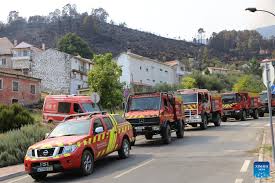Feature: In Portugal’s historic villages, flames test endurance and hope

Lisbon: Wildfires raging across central Portugal’s Gardunha mountains have encircled several historic villages, forcing evacuations and leaving others under siege.
Castelo Novo, one of Portugal’s officially recognized “12 Historic Villages,” known for its medieval ruins, picturesque scenery and cultural vitality that draw visitors year after year, is one of the hardest hit. Although the flames are now largely under control, firefighting crews remain stationed nearby, ready to respond to flare-ups at any moment.
On Thursday, as a Xinhua reporter entered the village, the acrid smell of smoke hung in the air, mingling with ash and haze. Flames have already licked the edge of the settlement; scorch marks scar the stone walls at the entrance, and the hills beyond lie charred, their blackened tree trunks leaning at awkward angles. From above, the scene resembles a quiet green oasis marooned in a desert of ash.
Many residents have been evacuated, but some villagers and visitors remain. They gather in the local cafe, sipping coffee as if to ward off the bitter smoke that hangs over the square.
Among them is Lopez, a Spanish tourist, who shrugged as he told Xinhua he never expected to encounter wildfires while traveling in Portugal.
“Wildfires in Spain are even worse. So we’ve given up moving around – we’ll just stay here a few days,” he said.
Eighty-year-old Lourenco Inacio’s home sits at the edge of the village, separated from the flames only by a narrow road.
A few days ago, when the fire was at its worst, flames shot six or seven meters high, he recalled. Driven by the strong wind, the wildfire surrounded the village in less than 30 minutes.
Inacio lives beside a viewing terrace built for tourists. Standing there, one would normally see verdant hillsides stretching into the distance. Now, only scorched slopes remain, a landscape of ruin.
Nights, residents say, are the most terrifying. Fires often reignite in the darkness, spreading from multiple directions.
“Fear doesn’t help,” Inacio said. “You can’t just watch everything burn away. I’ll stay and fight until the end.”
Another villager, Antanio Barroso, also refuses to leave. His orchard has been destroyed, but his house still stands.
Running his hand along a wall blackened by smoke, he said, “This house is all I’ve worked for in my life. I can’t abandon it. I’ll stay and fight alongside the firefighters.”
About 40 kilometers away, the village of Unhais da Serra is now another frontline. Nestled at the foot of Serra da Estrela, the highest peak on Portugal’s mainland, it has seen its surrounding national forest reduced to ashes. Along the main road, dozens of fire trucks and more than a hundred firefighters are deployed to prevent flare-ups.
Firefighter Gomes told Xinhua that crews from across the country have been battling here for a week, taking turns to rest wherever they can.
According to the European Forest Fire Information System (EFFIS), wildfires in Portugal have scorched more than 278,000 hectares so far this year, second only to the record 563,000 hectares burned in 2017.
In terms of land area affected, Portugal ranks first in Europe, with 3.03 percent of its territory burned – far above the long-term average of 1.05 percent.
Portugal has been under nationwide alert since Aug. 3 due to extreme heat that has heightened wildfire risk. Two people have died in Portugal as a result of wildfires this year.
With extreme heat persisting across the Iberian Peninsula, Portugal’s wildfire threat remains acute. For the residents of Castelo Novo and Unhais da Serra, these ancient villages are more than just homes – they are history and heritage that must be defended.





